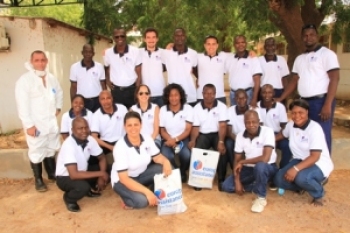The time has come, as the epidemic is at long last showing signs of gradually subsiding, to ask ourselves what lessons we have or should have learned, and what we could do to make ourselves less vulnerable to the impact of infectious disease outbreaks on our workforce and that of our clients.
Last fall numbers were still growing and efforts still had to be stepped up to fight the epidemics progression. Several measures were implemented by local governments, international organizations, NGOs and private sector to first of all reduce the incidence of cases, but also to geographically contain the epidemic and also to start addressing the economic and social reconstruction required after such a devastating event.
Systematic plans are now in place in various areas, and international medical assistance companies are now better equipped to support their clientele.
Numbers have started going down and commitments up
Last figures (8 April 2015) published by the World Health Organization (WHO) show that there have been 25,515 cases and 10,572 deaths since the beginning of the epidemic, but that the number of new cases for the least week had been the lowest for almost a year.
There were no new cases in Liberia and figures in both Guinea and Sierra Leone showed a marked decrease.
At the same time, under the stewardship of the newly created UNMEER (United Nations Mission for Ebola Emergency Response, created September 19th 2014), the international community has worked together to stop the outbreak through four strategic actions: case management, case finding and contact tracing, safe and dignified burials, and social mobilization. Funds have been dedicated to aid the fight against the progress of the epidemic. And among those 1 Billion USD pledged by World Bank partners.
There are still warnings that the impact is not over, and on the need for a long-term reconstruction of the economies of the three most affected countries, Guinea, Liberia and Sierra Leone. However the immediate needs for treatment are reduced and plans for decommissioning some treatment facilities have been activated. The outbreaks in all other countries, notably concerning ones in Nigeria and Mali, have been contained, which illustrates the quality of the response in those countries.
On the scientific front, this emergency triggered accelerated research efforts focused on the development of vaccines which are now being treated, as well as on the use of immunological and antiviral therapies, which are also in the process of being tested.
The Involvement of Europ-Assistance in planning for this type of contingency
The Europ Assistance group had to react on one hand to protect its clients in affected areas and in neighboring countries, and to be prepared to eventually evacuate or repatriate potentially affected clients.
This involved some direct actions on the ground, as some facilities, such as those in Port-Harcourt, Nigeria, were at some point directly threatened by contamination. The rapid deployment of solutions centered on the establishment of triage and patient isolation mechanisms, and on the equipment and training of staff in the proper use of such equipment. This confirmed the need to plan ahead of time, and to take into account facts such as resistance from members of the staff to go to work, or to comply with the strict circulation control regulations, by investing on extensive information to all staff, including those not on site or off rotation. The essential messages was that compliance with rules does provide almost fool-proof protection and that industrial activities can be maintained despite such threats. Thresholds at which activity reduction and even site evacuation must be implemented are part of the plans to be put in place.
While initially the overall public health strategy of non-affected countries was to keep the disease away from their countries, certain evacuations and repatriations did take place, and in some cases this resulted directly or indirectly in the triggering of limited local outbreaks. Initially only military aircraft and one private provider mandated by the military were able to safely conduct air ambulance flights with Ebola patients or high risk contacts on board, then several air ambulance providers developed solutions. Europ Assistance France, under the leadership of its medical director Dr. Daniel Boulanger, purchased isolation units and trained staff in order to be able to fly clients back should it be required. The acquisition of such a capability is an investment to best prepare to respond to future public health emergencies.
The main lesson is that development of corporate plans for all entities with large numbers of staff, mainly in isolated environment with limited local resources is a cost-efficient investment. Going ahead with such a planning exercise and not while under the direct threat of an emergency such as Ebola can be optimal, as it allows stepwise implementation and does not require any “corners to be cut”.